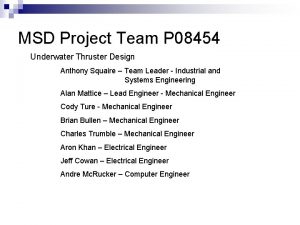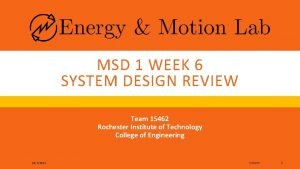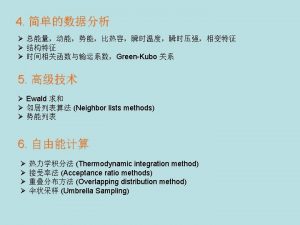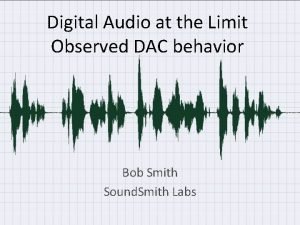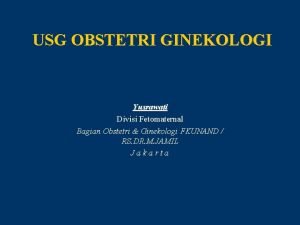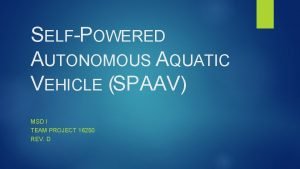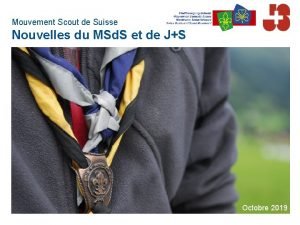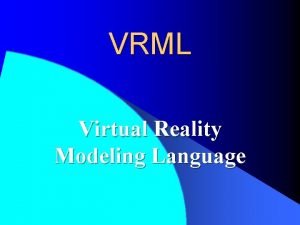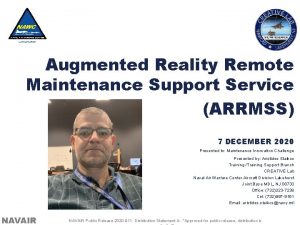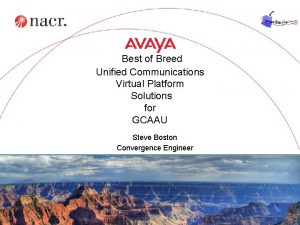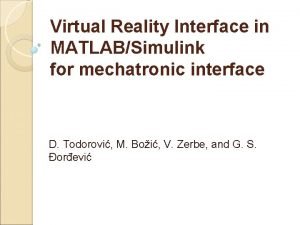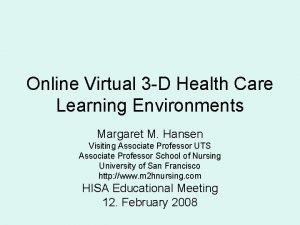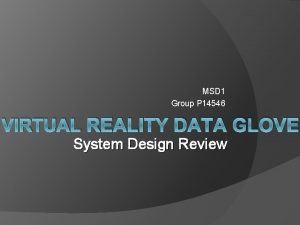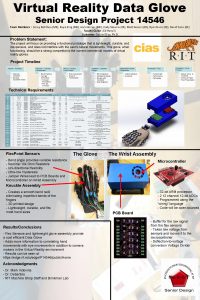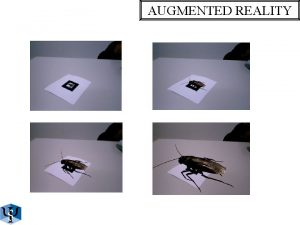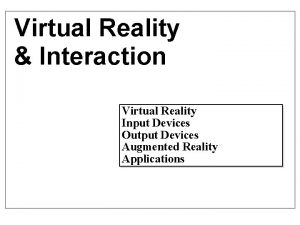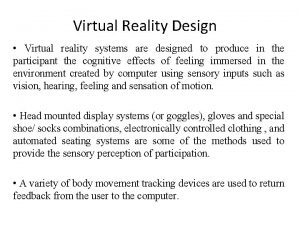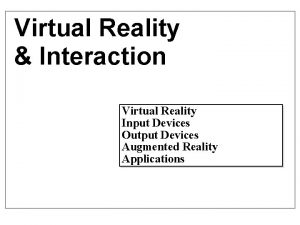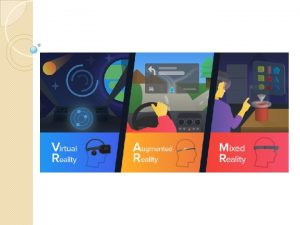MSD 1 Group P 14546 VIRTUAL REALITY DATA



































- Slides: 35

MSD 1 Group P 14546 VIRTUAL REALITY DATA GLOVE System Design Review

Introductions Name Role Corey Rothfuss Team Leader Kayla King Mechanical Engineer Josh Horner Mechanical Engineer Ryan Dunn Electrical Engineer David Yoon Electrical Engineer Matthew Nealon Electrical Engineer Cody Stevens Electrical Engineer

Agenda � Project Overview - Background � Problem Statement & Deliverables � Market Analysis � Customer Needs � Engineering Requirements � System Analysis � Engineering Matrix � Functional Analysis � Concept and Architecture development � � Engineering Analysis Risk Assessment Test Plan Project Plan

Background

Current Concept Virtual Reality is used to simulate 3 D environments using multiple cameras, sensors, and immersive displays � Most people know it from video games but it can be used for research applications � � Relate eye movements to their corresponding body movements Training in specialized tasks Healthcare Current techniques use markers in combination with cameras to track hand motion � In some positions, markers are occluded from optical view, resulting in missing data points �

Current Concept

Problem Statement � Current State � Current techniques use active markers with cameras to track hand motion � Desired State � The project will focus on providing a functional prototype that is lightweight, durable, and relatively inexpensive � The glove will not interfere with user’s natural hand movements � Sensors transmit motion data to the computer for analysis � Project Goals � Analyze current designs � Identify opportunities for improvement of benchmarked designs ○ Lighter ○ Better data rate ○ More accurate ○ More sensors � Constraints � Must be able to stay within budget means

Additional Deliverables � Functional Prototype that will be used in the center for imaging science for the Virtual Reality room � Test Data verifying correct operation � User manual for operation

Stakeholder(s) Primary Customer: Gabriel Diaz � Contact: Gabriel. Diaz@rit. edu 585 -317 -3595 � Secondary Customer: Susan Farnard � Contact: Farnard@cis. rit. edu 585 -475 -4567 � Faculty Guide: Ed Hanzlik � Contact: echeee@rit. edu 585 -475 -7428 � Sponsor (financial support): RIT �

Open Items From Last Review Refine Customers needs, Engineering Requirements and relationship matrix � Benchmark what types of sensors we could use � �Accuracy of them �Cost �Feasibility Find a better name than VRDG � See Virtual Reality room in person � �This morning

Customers � Military Training � Medical Students for training � Gamers � Film � Education � Research (our focus)

Market Trends � Market for Virtual Reality and VRDG � 2013: $0. 9 billion �Projected 2018: $1. 06 billion � Categories of markets �Gaming �Research/Learning �Military

VRDG Market Leaders University Projects. Virtual Realities Essential Reality Fifth Dimension Techonlogies Immersion Corporation

Customer Requirements

Engineering Requirements

Benchmarking Specs Current Market Comparison Specification Unit of Measure 5 DT Data Glove Wired 5 DT Data. Glove Wireless Human Glove S 1 Angular Position Accuracy ⁰ 1 <1 - - 0. 4 S 3 Flexure Sensor Type - Piezo. Resistive Piezo-Resistive Fiber Optic Hall Effect S 4 Sensor Count Discrete 20 18 - 22 14 14 20 S 5 Sensor Repeatability ⁰ - 3 - - 6. 17 S 6 Sensor Linearity % std - 0. 6 - - - S 7 Data Rate Hertz 120 75 -100 - S 8 Cost (per pair) $ 500 -1000 30, 000 - 40, 000 2, 000 3, 500 - S 9 Weight kg 0. 90 - < 0. 30 - S 10 Battery Life Hours 4 2 S 11 Communication Interface - RS-232 Wifi S 12 A/D Converter Bits 12 12 12 (10 typ. ) - S 13 Min Dynamic Range Bits - - 8 8 - S 14 Power Supply Voltage V 9 - - 9 - S 15 Power Supply Current Rating m. A - - - 150 - S 16 Communication Range m 6 30 - Specification Number Target Value Cyber. Glove III 8 Bluetooth (or RS 232) USB 1. 1 (or RS-232) -

System Analysis

Relationship Matrix

Functional Decomposition Track Hand Movement Measure movement Put on Hand Secure measurement instruments Measure Wrist Flexion Adjust to hand sizes Measure angle of finger flexion Connect to Computer Measure twist of wrist Measure Span of fingers Transmit Data Mount Sensor Pre-process Data Locate Sensor Collect Data Connect Wires

Alternatives Considered

Alternatives Considered

Alternatives Considered

Alternatives Considered

Alternatives Considered

Pugh Chart

Pugh Chart

Selected Concept #1 Pros: � Uses Flex Sensors � Finger flexion � Wrist flexion ○ Commonly used in other models currently on the market � Camera Markers for wrist rotation � Lightweight � Accurate � Positional Sensors � Fits multiple hand sizes without the need for multiple gloves Cons: � Springs for finger separation � May not be safe � May impede natural movement

Selected Concept #4 Pros: � Camera Markers for wrist rotation � Lightweight � Accurate � Adjustable Knuckles � Fits multiple hand sizes without the need for multiple gloves � Sensors between fingers � Safer than springs � Skeleton figure � Easily repairable Cons: � Uses Hall-effect Sensors � Finger flexion � Wrist flexion ○ � Not as accurate as flex sensors Sensors between fingers � May impede natural movement

Power Supply Concept Architecture User Glove Processor Computer Interface Sensors • Fingers/Wrist Outputted Data

Engineering Analysis Needed � The amount of force hands require to open and close � To determine the force it would take to restrict movement � Determine best material for glove to minimize wear while retaining comfort � For not restricting natural hand movements and to be comfortable � Determine current and voltage needed to operate system � To determine if USB can be sufficient enough power � Estimate system weight � To determine if glove would be too cumbersome for the hand � Determine data rate transfer of sensors and microprocessor � Finding correct digital converter and microcontroller � Determine sensor and microprocessor size restrictions � Find area it covers and compare them with fingers size � Determine what is a feasible for a range of accuracy for sensors � Review sensors, digital converters, chip, and microcontrollers and add up maximum error

Risk Item What if the budget is too low Effect Not being able to complete the project Cause Not having enough funding Severity Importan ce ID Likelihoo d Risk Assessment 3 9 27 9 1 9 3 1 Not enough competency do the required task First project was cancelled and lost critical time Action to Minimize Risk Find out budget early, benchmark research costs, order on time to save on delivery costs Seek out help, Use online resources, speak with guides and champions, teammates Owner Team 2 Technical Expertise 3 Setback Time 4 Distributing work Needing to do more research Not being able to meet critical deadlines/deliverables People are idle and one person is overworked 5 Conflicting Customer Needs Not being able to meet goals Budgetary, expertise, time, or physical restrictions 3 3 9 6 Change in Customer Needs Not being able to complete that goal New programming language, lab went wireless, etc. 3 1 3 Scheduling Conflicts Underperforming Team member Can’t get together to do important team tasks His share of work is not completed 7 people with different schedules 9 3 27 Schedule additional meeting times to make up for the time allotted Others focus on others aspect of projects. Iterate project planning and estimate the time it will take Talk to Professor Diaz and Ed Hanzlik and discuss options of either alternate plans or lowered expectations for deliverable goals Adapt to the new needs and discuss options of meeting those goals. Frequent communication with professor Diaz Updating Google Calendars, facebook, text, etc. Find a time to meet 3 3 9 Communicate with team and guide Team Make a well done project plan, iterate on the project plan, consult with guide and customer Team 7 8 9 10 11 12 13 One person task but heavy workload 9 1 9 Too busy, lazy, etc. Poor project plan, Not knowing what/when poor it is due, missing communication, Poor Planning deliverables unclear goals Too much interference High density of from electrical noise to be electronic devices, accurate Inaccurate data lack of shielding Weight of glove is Restricts natural hand Too much weight unmanageable movement from sensors Selected concept needs Poor concept adjustment(s) Lost valuable time selection Didn’t order it early enough, Chose Lead time for parts is too Lost valuable time USPS long 3 3 9 9 3 27 3 9 27 1 3 3 More advanced signal filter techniques Make the glove lighter, find more lightweight sensors Re-iterate concept selection process 3 3 9 Choose Fed. Ex, UPS, or DHL. Order it early Team/Hanzlik Corey Team Customer/Tea m Team EE Team

Test Plan Outline � Test accuracy of sensors �Verify +/- degree error � Test robustness of glove �Fatigue test or find SN curve of glove � Test sensors ergonomics �Put on fingers and see if they restrict movement ○ Too heavy, too big for fingers, etc. . � Test if USB is enough power for the system or if a additional power source is needed �Plug it into the microcontroller and see if it works

Project Plan (WK 6 -9)

Current Concepts for VRDG Name Manufacturer Cost Number of sensors Type of sensor Sensor accuracy Glove Material Special Features Humanglove Cyberglove 3 Humanware Cyberglove Systems Information not available Approx $30, 000 20 22 Hall effect Strip flex potentiometers about 1 degree < 1 degree Fabric Tight-fitting elastic fabric High thumb accuracy Lightweight, onboard ADC

Questions?
 Andre mcrucker
Andre mcrucker Msd bullying
Msd bullying Msd basics review
Msd basics review Mean square displacement diffusion coefficient
Mean square displacement diffusion coefficient Msd
Msd Msd menu
Msd menu Mousai msd192 dac
Mousai msd192 dac Msd exchanger
Msd exchanger Gambar janin 5 minggu di usg
Gambar janin 5 minggu di usg Spaav
Spaav Msd propecia 1mg
Msd propecia 1mg Msd suisse
Msd suisse Tim pennock
Tim pennock What is vrml
What is vrml Input devices for virtual reality
Input devices for virtual reality Oman drydock company logo
Oman drydock company logo Tom campbell experiments
Tom campbell experiments Augmented reality business cards
Augmented reality business cards Virtual reality modeling language
Virtual reality modeling language Mobile virtual reality service
Mobile virtual reality service Augmented reality remote maintenance
Augmented reality remote maintenance Virtual reality unified communications
Virtual reality unified communications Brief history of virtual reality
Brief history of virtual reality Conclusion on virtual reality
Conclusion on virtual reality Conclusion for virtual reality
Conclusion for virtual reality Virtual reality joke
Virtual reality joke Pros and cons of virtual reality in healthcare
Pros and cons of virtual reality in healthcare All children can learn slogan
All children can learn slogan Transactional analysis group therapy
Transactional analysis group therapy Has virtual functions and accessible non-virtual destructor
Has virtual functions and accessible non-virtual destructor Augmented reality big data
Augmented reality big data Social psychology definition psychology
Social psychology definition psychology Y = a(b)^x
Y = a(b)^x Anova within group and between group
Anova within group and between group Unsocial group example
Unsocial group example Group 1 and group 2 specialties
Group 1 and group 2 specialties
